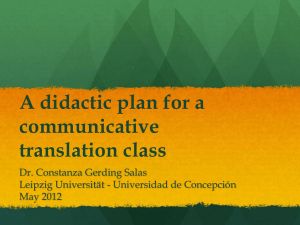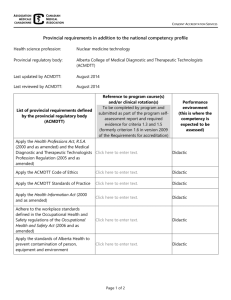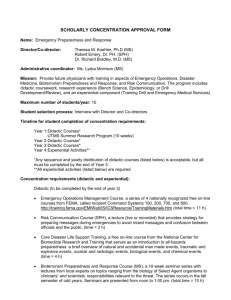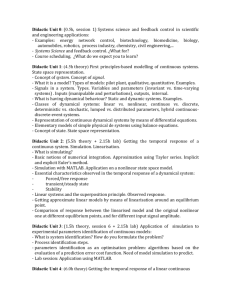5) bibliography
advertisement
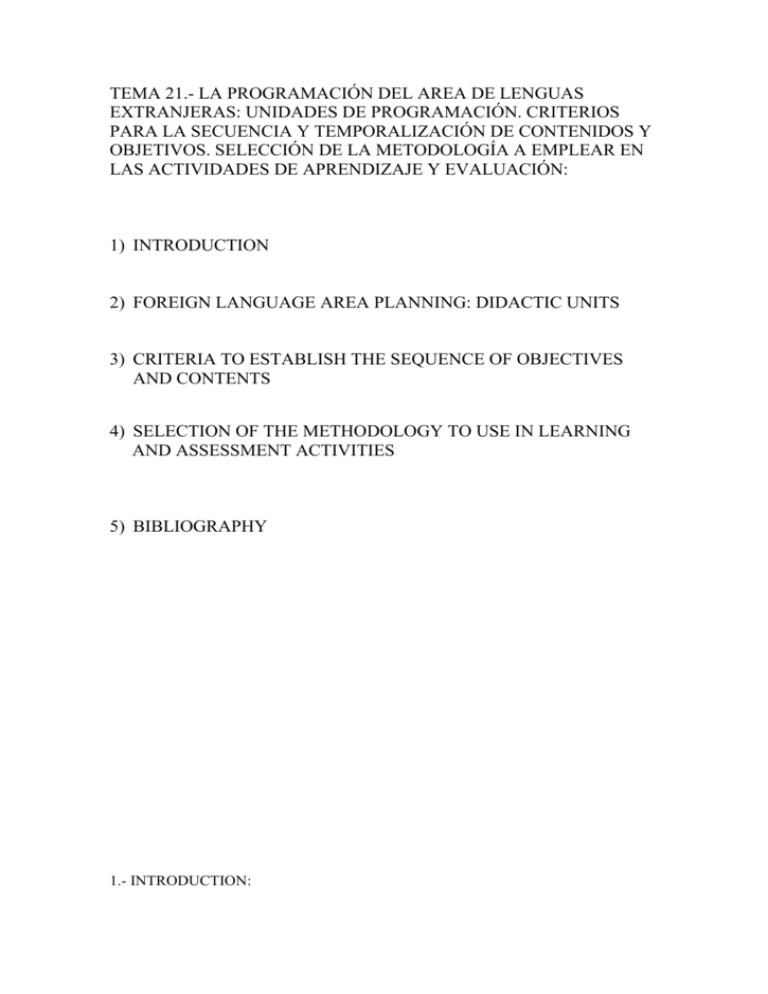
TEMA 21.- LA PROGRAMACIÓN DEL AREA DE LENGUAS EXTRANJERAS: UNIDADES DE PROGRAMACIÓN. CRITERIOS PARA LA SECUENCIA Y TEMPORALIZACIÓN DE CONTENIDOS Y OBJETIVOS. SELECCIÓN DE LA METODOLOGÍA A EMPLEAR EN LAS ACTIVIDADES DE APRENDIZAJE Y EVALUACIÓN: 1) INTRODUCTION 2) FOREIGN LANGUAGE AREA PLANNING: DIDACTIC UNITS 3) CRITERIA TO ESTABLISH THE SEQUENCE OF OBJECTIVES AND CONTENTS 4) SELECTION OF THE METHODOLOGY TO USE IN LEARNING AND ASSESSMENT ACTIVITIES 5) BIBLIOGRAPHY 1.- INTRODUCTION: The Organic Act 1/1990 of General Arrangement of the Educational System introduced some important changes, aimed at improving the quality of education in Spain. Among these changes we can mention: - The extension of compulsory education to the age of 16 years old - The establishment of new educational stages such as: Infant, Primary and Compulsory Secondary Education. - These stages are organised in cycles, which is the period that should be considered for teaching programs and promotion. - The establishment of a curriculum which, in spite of having certain aspects which are compulsory for all the country, is also open and flexible, as the different autonomous educational services could adapt it to their real context. Then, each school should adapt the official curriculum to their real environment by means of the design and development of the Curricular Project. - Every teacher should design his/her particular teaching planning according to the decisions taken in the Curricular project. Then, taking into account these basic aspects of the Educational Reform, we are going to deal with: - The elements and specific characteristics of foreing language teaching planning. - The criteria we must take into account for the sequence of objectives and contents - The methodological principles we should bear in mind to design the learning and assessment activities. 2.-FOREIGN LANGUAGE AREA PLANNING: As we have said before, our educational system establishes and open and flexible curriculum which must be adapted to the particular needs of students through different levels: The First level, refers to the official curriculum which contains the general objectives of each stage for the different areas, their blocks of contents and assessment criteria. The Second level, includes the Curricular Project of each stage, where each school adapts the elements of the official curriculum to its particular context. According to the R.D. 82/1996, the Curricular Project should include the following elements: - The general objectives of the stage adapted to the socio-cultural context of the school. The sequence of objectives, contents and evaluation criteria of the different areas per cycle. General methodological decisions that affect the following aspects: Methodological principles, groupings, space, time and materials. General decisions about the attention to pupils with special needs. And finally in the third level of curricular development, each teacher should design his/her teaching planning which consist of a set of didactic units, taking into account the decisions made by the teaching staff in the Curricular Project. Then the teaching planning is defined in the curricular material known as Red Boxes as: ‘the process whereby, starting from the official curriculum and the decisions taken in the Curricular Project, teachers plan the work that is going to be developed in the class. As a result, we have a set of sequenced didactic units for a given cycle’. Teaching planning should be: Adapted to the context and pupil’s needs Flexible, which implies that we must be ready to change any of it elements if we feel that they are not appropriate for a particular group of students. Concrete, as it should give clear information about the teaching/ learning process which is going to be developed in the classroom. Realistic, as the teacher should have the space, time and materials to carry out the activities he/she has designed and this activities should be adapted to the student’s level. Teaching planning covers two aspects: 1. First, it includes several general decisions to ensure the coherence of the teaching process and the link between the different didactic units throughout the cycle. These decisions, which are taken by the teaching staff of the cycle, deal with : - Arrangement and sequence of contents throughout the cycle - General guidelines about: space, time, materials, pupils groupings and evaluation 2. In the second place, the teaching planning includes the design of the didactic units. In relation to the design of didactic units the teaching staff of the cycle should: Find topics which meet the students interests and needs Decide the objectives and contents to be worked on in each unit. Design activities according to these objectives and contents. Choose the materials suitable for each unit. Decide about the strategies to assess the students performance and the teaching practice. Now, we are going to deal with the first aspect we have mention, the general decisions to ensure the coherence of the teaching process throughout the cycle, which include: THE SEQUENCE AND TIMING OF OBJECTIVES AND CONTENTS. 2.1.- CRITERIA TO ESTABLISH THE SEQUENCE AND TIMING OF OBJECTIVES AND CONTENTS: As we have seen when talking about the Curricular project, one of the decisions made in such document is the sequence of objectives, contents, and assessment criteria of each area along the different cycles. Then, once the teaching staff has decided the objectives and contents programme per cycle, in the Curricular Project, the cycle teacher or teachers have to decide about the sequence and timing of these objectives and contents within the cycle. The term sequence refers to the order in which we are going to present the contents while the term timing refers to the amount of time we will need to achieve the objectives and teach the contents. Since the establishment of this sequence is a difficult task, the Ministry of Education published a Resolution of the 5th of March 1992, that offered some criteria to establish such sequence: 1. The objectives and contents should be related to the global aim of Foreign language learning , which is the acquisition of communicative competence. 2. The objectives and contents should be arranged in a meaningful way 3. The arrangement of objectives and contents should ensure the coherence of the learning process Regarding contents this Resolution says that: 1. We must go from the general and simple to the particular and complex. This applies to the arrangement of concepts and procedures, since it is difficult to arrange attitudinal contents into cycles. 2. There must be a balance between the three types of contents (concepts, procedures and attitudes). 3. As far as the procedures are concerned, the four skills should be developed in an interrelated way as they are in real communication. 4. However we must remember that in the Foreign Language Area curriculum for Primary Education, oral skills are stressed over written skills, and receptive skills are given the priority over productive skills. 5. Contents must be adapted to the students level of development: According to PIAGET and INHELDER (1984) children are at the concrete operational stage (between 7 and 11 years old) The characteristics of this stage are as follows: Children start to develop rational thinking starting from concrete objects, classes or relations. Children make progress in perceptive and motor aspects. Children begin to develop socialisation skills. According to these characteristics we must remember the following guidelines: If children mental operations are based on their concrete experiences, we, as foreign language teachers, should select topics and activities connected to the pupils real experiences. If children develop their perceptive and motor abilities, we should contribute to this development by means of contents and activities which involve body movement or the use of their perceptive and creative abilities. We should also foster the development of socialisation skills. In this sense we should promote the development of positive attitudes such as co-operation and respect towards the contribution of others. 6. The contents should be presented in context. The new grammatical structures and vocabulary must be learnt in connection with the communicative functions that children need to express themselves in situations related to their needs and experiences. When planning the sequence of objectives and contents we must take the following steps: 1. We must decide the degree in which the abilities expressed in the general objectives are going to be developed in each cycle, and choose the contents we need to reach them. For instance, starting from the objective number one of the foreign language area: ‘To understand simple and oral written texts about known objects, situations and events, using general and specific information taken from those texts for specific purposes.’ We can sequence the abilities expressed in this objective, for the second cycle of Primary education, as follows: ‘At the end of the second cycle pupils will be able to understand the general meaning of simple oral texts emitted by the teacher with a simple structure and vocabulary, in familiar contexts, and with the help of gestures, mime and any necessary repetition’ 2. As we must teach the three types of contents in an interrelated way, we must choose any of them to organise the sequence. The best way to promote the development of communicative abilities is organising them around procedures. If we decide to do it in this way, we should consider the factors which determine the sequence and the degree of complexity of the communicative functions, since these will be the factors to be taken into account to set the sequence of contents. These factors, which are defined in the Resolution of the 5th of March, are: - The type of oral or written texts The channel The type of comprehension The interlocutor The level of correction Now, we are going to explain these criteria in detail.: - The type of oral or written texts Here we must consider the length, vocabulary, the linguistic structures, and organisation of the oral or written texts that we are going to use in class. Obviously, we must go from short simple texts to more complex ones. - The channel As far as channel is concerned we should consider if the oral or written messages that our students should understand or produce are going to be transmitted in a face to face communicative situation, or by means of a cassette recording or a written text. In this sense, we should start from face to face communication, because mime, gestures and expressions help pupils to understand. - The type of comprehension The type of comprehension refers to the information we ask them to extract from an oral or written message. This comprehension may be global ( if they should get the general sense of the message) or specific (if they have to extract specific details). The most logical progression goes from global to specific comprehension. - The interlocutor Regarding the interlocutor we should take into account if he/she is known or unknown for the student, if he/she belongs to the school context or not. At the beginning we should work with close interlocutors such as the teacher and the classmates. - The level of correction The level of correction deals with the demands about correction in the oral and written production of students. Obviously such demands increase along the cycles. At the beginning, they should produce language correctly enough to be understood. 3 .- Then, if we have decided to organise contents around procedures, we should not forget that the three types of contents (concepts, procedures and attitudes) must be considered in an interrelated way. Then we should relate them as in the following example: “Recognising the characteristic sounds, rhythm and intonation patterns of the foreign language, realising the importance of being able to communicate in a foreign language To see this relation more clear, the Resolution of the 5th of March suggests that we can display them in a chart, as follows EXAMPLE OF SEQUENCE OF CONTENTS FOR THE SECOND CYCLE Procedures Concepts Attitudes Recognising -Characteristic sounds -Rhythm and intonation patterns. Identifying -Words and sentences in texts - Showing an optimistic related to the context of the attitude towards their own classroom and daily life ability to understand the foreign language - Global comprehension - Realising the importance of oral communication in a foreign language. of messages with the following communicative intentions: *Greeting (hello!,good morning...) *Identifying oneself (I - Showing a receptive attitude towards people who speak a am. ,My name is...) *Giving and asking for different language. basic personal information (using expressions such as: What´s your name, How old are you?...) - These communicative functions should be related to topics of general use and wide notions, which are interesting for children, such as: *The school, family, friends, animals, body, home, numbers, colours... Specific comprehension Of information - Showing a receptive attitude previously required towards people who speak a in contextualised foreign language. situations* *For instance, we ask children to fill a chart about the favourite sports of different characters from the textbook. First, we tell them what they are going to listen to a conversation where the characters talk about things they like and dislike and what information they should pay attention to. Then, we play the cassette or read the text aloud and they should complete the chart, with the specific information we have asked them for (sports, in this case) TENNIS BASKETBALL FOOTBALL STEVIE yes yes no LUCY yes no yes ANNIE no yes no As we can see this task ask them to extract specific information (about favourite sports), previously required by the teacher, in a contextualised situation,( as they already recognise the characters voices, and know what they are talking about). If we do this with all the general objectives we will have a list of the contents of each cycle including concepts procedures and attitudes. These orientations are quite useful to establish the sequence of objectives, contents and assessment criteria, in the second and third cycle, but we must not forget that English has been introduced in the 1st cycle in our Autonomous Community. Then the Order of 30th of August published by the Department of Education, Science and Technology of our Autonomous Government says in its article number 3 that: “The centres must change and adapt their Curricular Projects to this change as the objectives, contents and evaluation criteria of the foreign language area, should be sequenced for three cycles, instead of two” Obviously, as we haven’t got our own curriculum yet, we must take as reference the objectives, contents and evaluation criteria of the R.D. 1344/91 of the 6th of September, which establishes the national curriculum for primary Education. However, the Department of Education, Science and Technology of our Autonomous Government, has published a document, made by foreign language teachers co-ordinated by the Technical Inspection Service called “English in the first cycle of Primary Education”. This document is not a law, it has been published just to help teachers. Regarding the abilities, skills and contents which should be worked in this cycle this document says that: In the FIRST CYCLE: - The most important skill in the first cycle should be listening. - We must not force children to speak until they are ready to do it. Then at the beginning they can show what they have understood by means of non-verbal actions such as movements, gestures, drawing, cutting, pointing, colouring... - Total Physical Response ( TPR) activities and songs are a good way to help them link words and actions, and express themselves in English in a funny and meaningful way. - Written language should be avoided, especially in the first year of the cycle, because they are learning to read and write in their native language and the complex English spelling could be confusing for them. - Contents should be taught by means of didactic units, organised around meaningful topics such as:, Family, Friends, Christmas, Things of the classroom, The house, Food, Toys, Clothes... - Children must be already familiar with such topics in their native language. Then, the co-ordination with the class-teacher is very important to establish the sequence of the different didactic units along the cycle. 2.2.- DIDACTIC UNITS: Now we are going to talk about the second moment of the teaching planning: the design and development of didactic units. Didactic units are defined in the curricular material known as Red Boxes published by the Spanish Ministry of Education (1991) as: A unit of educational action formed by a set of activities that are developed in an specific time, to reach a set of didactic objectives. A didactic unit is the answer to all the curricular questions: - What to teach? In the form of Objectives and contents - When? Through the sequence of objectives and contents. - How? By means of the learning activities, space and time organisation, didactic resources and materials. - And what, when and how to evaluate, by means of the assessment criteria, and the different activities to carry out the initial, formative and final evaluation A didactic unit should have the following elements: 1.- Description 2.- Didactic objectives 3.- Learning contents 4.- Activities 5.- Materials 6.- Space and time arrangement. 7.- Evaluation criteria and techniques used to carry out this process. We are going to analyse this elements in detail: 1.- The Description is a kind of introduction which includes : The topic of the didactic unit A brief reference about pupils´ previous knowledge Cycle/ level and term Number of sessions Connection with the previous didactic units 2.-The didactic objectives are more specific than those designed for the cycle as they express the abilities that we want pupils acquire as a result of the work developed in a given didactic unit. The didactic objectives must meet all the students’ needs. This means that the teacher should include some basic objectives as well as more difficult ones designed to reinforce the acquisition process. In this way everyone could progress according to his / her possibilities. 3.- Learning contents: The didactic unit must include the three types of contents ( concepts, procedures and attitudes) taking into account that: There must be a balance between them They should be interrelated and connected to the students experience and needs. The teacher should include contents related to cross-curricular topics ( health, peace, environment protection...) 4.- Activities or learning experiences: Once we have explained the main criteria to design the learning activities, we will focus on evaluation activities : The general methodological principles for Primary education, included in the R.D. 1344/ 1991 of the 14th of June, evaluation is considered as a global and continuous process, which must be used as a tool to improve the teaching/learning process. According to the document “Keys for the teaching of a foreign language(MEC,1991) the main aim of evaluation in the foreign language area is “to check if students are able to use the language in communicative situations” Then, evaluation activities should not be different from learning ones. Direct observation of the students’ work is the main evaluation technique, however in order to make this observation in a systematic way the document “Keys for the teaching of a foreign language” suggests that we should use an evaluation form containing the aspects to be observed on each kind of activity. For example for the evaluation of oral activities this document suggest teachers to consider the following questions: Has he/she completed the activity? Does he/she understand the activity? Can he/she make her/himself understood by means of words and gestures? Is his/her pronunciation good enough to be understood? Does he/she need help from the teacher or other students? BIBLIOGRAPHY. - Ley Orgánica 1/1990, de 3 de octubre de Ordenación General del Sistema Educativo. - RD 1344/1991 de 6 de septiembre, por el que se establece el currículo de la Educación Primaria. - RD 82/1996, de 26 de enero que establece el Reglamento Orgánico de las Escuelas de Educación infantil y colegios de Educación primaria. Resolución de 5 de marzo de 1992, de la Secretaria de Estado para la Educación, que regula la elaboración de proyectos curriculares y establece orientaciones para la distribución de objetivos, contenidos y criterios de evaluación. - - - Orden del 30 de agosto de 2000, por la que se establece y regula la impartición de la lengua extranjera en el primer ciclo de Educación primaria, en el ámbito de la Comunidad Autónoma de Extremadura. MEC: Materiales para la Reforma, area de lengua extranjera. Madrid. Servicio de publicaciones del MEC. 1991. - MEC. Proyecto Curricular. Materiales para la reforma. Madrid. Servicio de publicaciones del MEC, 1991. - Brewster, Ellis and Girard. The primary English Teacher’s Guide. London. Penguin. 1992.

